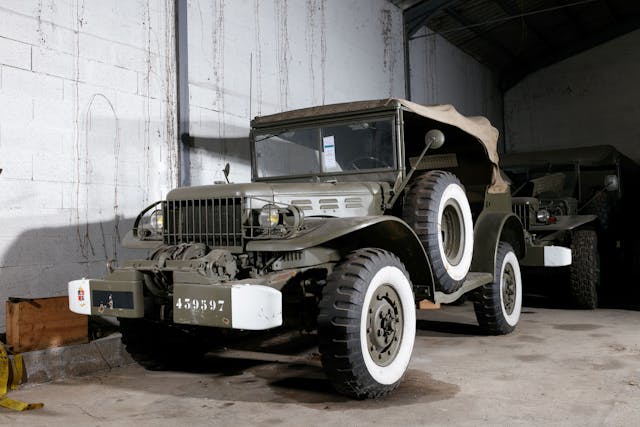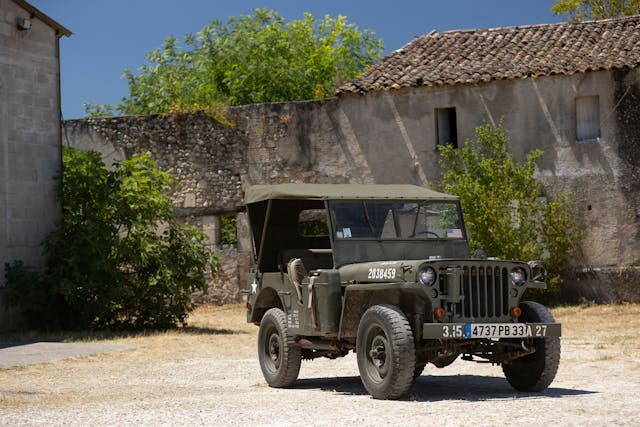Media | Articles
This French winemaker’s estate is loaded with military vehicles of WWII vintage
The late André Lurton has a familiar name that travels well beyond the vine-filled countryside of southwestern France. Following his service in WWII (beginning as a teen in the French Resistance and, later, the First Army), he returned through war-torn lands to an equally ravaged Entre-Deux-Mers, his homeland east of Bordeaux near the river Dordogne.
Shortly thereafter, at his family’s Château Bonnet, he led an expansion of their operations by acquiring surrounding lands and chateaus. Economic resurgence soon followed in the surrounding region, due to the tourism and renown that comes with a world-class reputation for exquisite wine. Lurton’s undeniable political and viticultural talent drove him to amass a fortune that could afford the means to own a limitless array of machines, but in the midst of all of the glitz, Lurton largely resisted the temptation of high-brow automobile collecting. Rather, he remained truer to his passion for unique war relics, likely influenced by the Second World War’s imprint on him during his days as a young soldier.
Lurton’s estate is destined for the hammer on September 27 at his birthplace of Château Bonnet, in Grezillac. The Artcurial sale is comprised of an eclectic bunch of both foreign and domestic makes/models, including the 10 military standouts listed below, all offered at no reserve, in ascending order according to their pre-auction estimate.
1940 Ward LaFrance Dépanneuse Lourde

Presale estimate: €7000–€10,000 ($8294–$11,848)
The Dépanneuse Lourde, or “Heavy Tow Truck,” was built by Ward LaFrance, an American outfit based out of Elmira Heights, New York. The company (1916–79) specialized in heavy equipment and firefighting trucks, so it comes as no surprise the military came calling with a contract in 1940. This example is an M1A1 6×6, a 10-ton behemoth and professional mover by trade, capable of towing up to 60,000 pounds or hauling a max payload of 8000 pounds. Such jobs were essential for managing inoperable machines or clearing obstructive wreckage from roadways. The red-and-blue painted markings on the doors and front fender displays the double-barred Cross of Lorraine (symbolizing a liberated France), suggesting this M1A1 may have ties to the Free French Forces under Charles de Gaulle. Artcurial notes that Lurton acquired this M1A1 in 2000 from a fellow enthusiast in Gironde, not far from his home.
Marketplace
Buy and sell classics with confidence
1942 Dodge WC-57 Command Car

Presale estimate: €10,000–€15,000 ($11,848–$17,772)
This classic Dodge WC-57 doesn’t hold anywhere close to the amount of weight that General Patton’s did when it sold, c’est la vie, but that shouldn’t suggest it will move at an egregious price. Thousands of Command Cars were produced over the duration of the conflict, but none with dazzling whitewall tires, an unoriginal look that will certainly either appeal in or detract from the value in buyer’s eyes. WC-57s primarily served as conventional people movers with a six-cylinder 3.8-liter engine. This example also bears the Cross of Lorraine in a weathered decal on the front bumper. Artcurial notes Lurton picked this up for his collection locally, in the city of Bordeaux.
1943 Dodge WC63 6X6

Presale estimate: €10,000–€15,000 ($11,848–$17,772)
Generally, there’s nothing all-too glamourous about the jobs asked of 6×6 big-heavies during the war, like this Dodge WC63 (G507). Famous generals or commanders never lay claim to one, rather it was the young foot soldiers such as Lurton that squeezed into them like sardines. Interestingly enough, the model code WC began with the intention of signifying W for model year 1941 and C for half-ton, but that logic quickly expired as subsequent model years, then 3/4- and 1.5-ton vehicles (like this WC63), adopted the letter designation also. This WC63 still wears its signature Braden winch on its nose. Artcurial notes that old registration documentation suggests the post-war life of this Dodge was spent in the services of a Fire and Rescue department in Vendée, an Atlantic coastal region north of Bordeaux.
1943 GMC D.U.K.W. 353 Camion Amphibie 6×6 “Duck”

Presale estimate: €10,000–€15,000 ($11,848–$17,772)
GMC D.U.K.Ws or “Ducks” typically live a hard life. It was this way from their origin. Fortunately, some originals remain intact with only typical pitfalls of aging. Lurton’s model appears to be one of them. Clammed up with a seized block and showing rust-spotted bodywork, the presale estimate of roughly $12–$18K seems fair, considering another engine is included in the sale. Fine restored versions go well beyond that number, and this example is far from a lost cause. It’s not surprising that Lurton had to have one in his collection, given its significance. Ducks were the ultimate answer to the question of amphibious warfare, putting Allied troops and supplies on the beaches of northern France effectively and turning the tide of the war. Fortunately, the mere fact that this machine isn’t left in shambles or sunk somewhere makes it one rare bird.
1942 Ford GPW “Jeep”

Presale estimate: €14,000–€18,000 ($16,587–$21,326)
At Château Bonnet, this 1942 Ford GPW could lay claim as the most romantic of subjects to nimbly ramble through sun-kissed vines. But that’s not when Lurton first fell in love with the Jeep. According to Artcurial, “He had a very personal attachment to this vehicle. In fact, in 1944 after enlisting at the age of 20 in the Guyenne battalion, he became the driver for Commandant Bartet and later Commandant Revol. André Lurton was particularly impressed by this ingenious type of vehicle and writes in his memoires of having 17 punctures in 23 days during the campaign in Germany.” The next caretaker of this prize will certainly bear the onus of carrying on the torch for the love of Jeep. Luckily, they won’t have to go far from Grezillac to do so. As documented by Hagerty author Aaron Robinson in his own 1944 Ford GPW, the Normandie coastline is gaining in popularity as a revered destination for enthusiasts on every anniversary of the D-Day invasion.
1940 Volkswagen Type 82 Kübelwagen

Presale estimate: €15,000–€25,000 ($17,772–$29,620)
Why the Kübelwagen? Given one question to ask Lurton about his collection, that would be it. His 1940 VW Type 82 is the only adversarial piece of the lot. The answer could be that he simply admired how collectible they are, but perhaps the real one is in the pages of his memoirs, much like his vivid recollections of the Jeep. Likewise to the GPW, the car-based Kübelwagen was to be the fleet-of-foot antidote made for travel on all kinds of terrain. In its post-war life, a much smaller production of around 50,000 turned them into the rarer and more sought-after restoration gem of the two. In March, a beautifully restored 1944 Type 82 example sold for $58,240 at Bonhams’ Amelia Island Auction. Arcturial notes that Lurton’s bucket car will come with Austrian documentation that tracks its story back to the early ’70s. The vehicle was acquired through European dealer Bruno Vendiesse in 2003.
1943 Ford M8 blindé léger “Greyhound”

Presale estimate: €18,000–€35,000 ($21,326–$41,468)
The Ford M8 was a light armored specialist in reconnaissance, more commonly recognized by its popular British given nickname, the “Greyhound.” The 5.2-liter, six-cylinder Hercules JXD engine made it capable of pushing a top speed of 55 mph, at nearly 17,500 pounds fully loaded. The remarkable advantage of the M8 in the war was its range of travel. With a range of close to 400 miles on a single tank of fuel, the quiet(er) cruiser could withstand long-ranged treks in and out of hostile areas with ease. Lurton took possession of it in 2000. It stands as perhaps the most practical of all of the big-barreled things in his arsenal. Now equipped with inoperable weapons, the Greyhound once possessed a functioning 37 mm anti-tank gun, along with 50-caliber and 30-caliber machine guns. In battle, the vehicle required a four-man crew including driver, radio operator, gunner, and loader.
1943 White Half-Track Type M3

Presale estimate: €20,000–€30,000 ($23,696–$35,544)
Through the eyes of a military outsider, this M3 made by the White Motor Company (1900–80) is probably the most unique-looking of the lot. A hybrid in every ancient sense of the word, the M3 utilized a standard axle up front and caterpillar tracks in the rear. The tracks provided luxuries of grip and surface area for moving the payload. Lurton’s collection had to include an example of this vehicle, given its historical significance as the first type of motorized vehicle to breach occupied Paris, famously dubbed the “España Cañí,” under General Leclerc’s command. At auction, comparable half-tracks of the period have gone for $38,000 and roughly $50,000.
1943 Ford Sherman M4A1 “Grizzly”

Presale estimate: €140,000–€180,000 ($165,872–$213,264)
Sherman tanks don’t just show up anywhere or very often on the market, even if boasting the highest production numbers for any tank in American history. Lurton’s example represents the first generation of the M4 Grizzly, a monster made from U.S. parts that underwent a final assembly by Montreal Locomotive Works in Canada. While it’s a sure-fire six-figure sale, this tank is far from original and will be best in the hands of a restoration-minded individual to ever get rolling again. Regulation and hard-to-come-by parts almost assuredly promise that this piece of history will remain in Europe. Even it remains inoperable, nothing is fundamentally more jaw dropping than a tour of someone’s personal tank, functionality be damned.
1942 M10 Tank Destroyer “Wolverine”

Presale estimate: €220,000–€250,000 ($260,656–$296,200)
What’s better than having one tank? Two tanks. This big brother to the Sherman Grizzly is further along and more functionally operational but will even include a bevy of spare parts as well as an instructional booklet in French. It’s rarity should not go understated. As the listing notes, this M10 is production number #305, which makes it one of the first series of 4992 examples built by the Fischer Body Company in the States between October 1942 and November 1943. Lurton found this one stashed away in mid-country Bourges in 2000. The Wolverine has to be one of the most imposing pieces of history one could legally obtain from the war. We’ll be watching this sale closely, as it’s difficult to predict how high the final number may go.





















